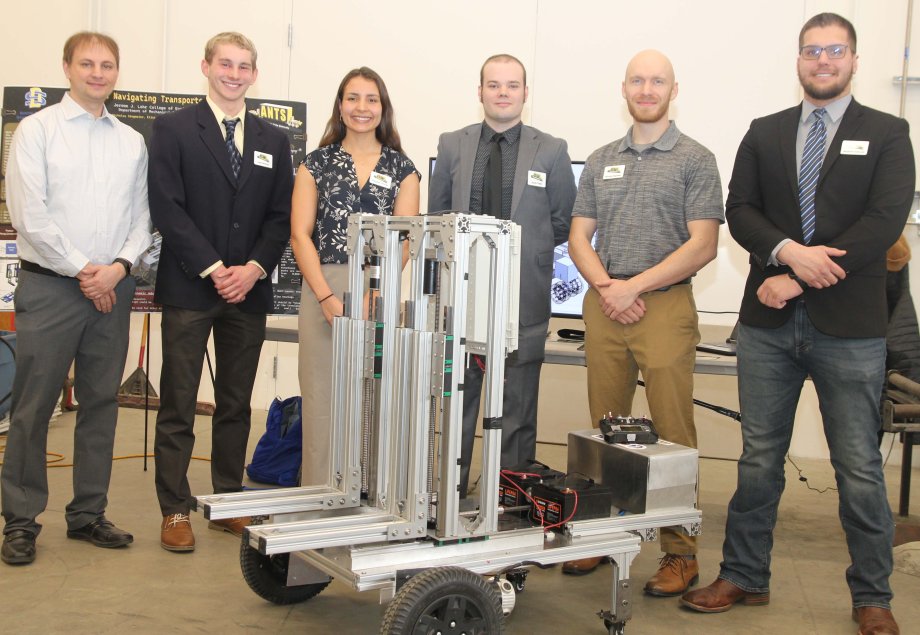
All systems are go for SDSU’s ANTS project.
This is no picnic pest but one of three projects coming out of the Jerome J. Lohr College of Engineering that has been selected as a finalist in a NASA competition.
RASC-AL Challenge Lunar surface transporter finalists
• South Dakota State University
• University of Maryland
• University of Texas
• Virginia Polytechnic Institute
ANTS, short for Artemis Navigating Transporter System, is one of 15 finalists in the 2023 RASC-AL competition, which is short for Revolutionary Aerospace Systems Concepts – Academic Linkage. Five mechanical engineering majors and their adviser, associate professor Todd Letcher, built a lunar surface transporter vehicle. There were four different RASC-AL challenges this year, and SDSU was one of four finalists selected in the lunar vehicle contest.
Each team received a $6,500 stipend to further develop and present its concept to a panel of NASA and industry experts in a competitive design review at the 2023 RASC-AL Forum in Cocoa Beach, Florida, June 12-14.
“Selected projects demonstrated originality and creativity in the areas of engineering and analysis, show feasibility and technical merit, and include synergistic applications with NASA’s planned current investments,” according to a news release from the National Institute of Aerospace, which administers the contest on behalf of NASA.
Sanjeev Kumar, dean of Jerome J. Lohr College of Engineering, said, “This is yet another example of what makes SDSU special. We have students who put their heart and soul into these projects. In turn, they are supported by dedicated faculty and modern, well-equipped facilities where students can convert their intellectual training into, literally, out-of-this-world projects.”
Large-scale design, scaled-down prototype
The RASC-AL contest has two different phases—the design of a transport vehicle that could be used on the low-gravity surface of the moon, and the building of a smaller prototype that can be used in a demonstration at the RASC-AL Forum.
At Cocoa Beach, the SDSU students will give a formal oral presentation with PowerPoint slides and then give a poster presentation where its prototype can be demonstrated.
The prototype is a specially designed forklift that is about the size of a go-cart.
Team member Nick Stegmeier said, “A full-scale ANT would be as large as a Volkswagen Bug, which is quite fitting. Two key features of the ANTS system are the collaborative lift capability, allowing the ANTS to lift very large and heavy payloads such as astronaut habitats, and the use of linear actuators and screws to enable the lifting systems, rather than the typical hydraulic systems that Earth-based forklifts use.
“Hydraulic systems are difficult to use on the lunar surface due the vacuum of space, making it difficult to keep a seal, and the likelihood of lunar dust contaminating the hydraulic system. We didn’t have time to build two ANT prototypes, which would enable demonstration of the collaborative lifting, so we decided to demonstrate the feasibility of a screw-driven lifting system.
“The ANT demonstration prototype has two screw-driven forks that can be controlled individually or synchronously. This enables lifting cargo on uneven terrain. For stability during cargo transport, the entire forklift assembly can be translated over the center of the prototype chassis using another screw and actuator.
“In addition, our prototype can be remotely controlled, just like the real ANTS system.”
Team aims for spot at Vegas conference
The SDSU presentation is June 12, one month from the date of this writing, and Letcher, the students’ adviser, said, “They’re in really good shape.”
Students will do some practice presentations online, and then the recently graduated seniors will fly to Florida from all parts of the country. The first- and second-place overall winning teams will be invited to present their work at the American Institute of Aeronautics and Astronautics conference in Las Vegas Oct. 23-25.
Kumar said, “This is what a land-grant institution is all about—providing an affordable education to students from all walks of life and giving them an opportunity to compete against their peers in the top engineering schools in the nation.”
- Contact:
- Telephone number: 605-688-4538
Republishing
You may republish SDSU News Center articles for free, online or in print. Questions? Contact us at sdsu.news@sdstate.edu or 605-688-6161.

